
Jumping on the privacy-geared mindset, information security company Copperhead has been working on a custom ROM for Android known as CopperheadOS. You can now buy Google’s latest Nexus devices with this custom operating system pre-installed.
The Toronto-based company says CopperheadOS is a “hardened open-source operating system based on Android,” and it features more privacy-centric features like alternatives to Google apps, and separate encryption and lockscreen passwords. The OS has been out for a few months now, and the company launched an online store in May where it sold the Nexus 5X, but you can now also grab the Nexus 6P with the secure OS.
The operating system is free, however, so if you know how to swap out ROMs you can simply grab it on the company’s website. And Copperhead is charging a lot more money for these devices with CopperheadOS pre-installed — the Nexus 6P costs $750 with CopperheadOS, whereas the same device only costs $500 on the Google Store. So of course you can go the cheaper route and buy a Nexus 6P and then install the OS for free, but buying directly from Copperhead at a higher price supports the company, and helps it keep the bills paid.
Copperhead’s secure OS is only targeted at Nexus and Pixel devices, and the company states that it will support these devices for as long as Google does.
Editors' Recommendations
- iOS 18 could make my iPhone look like Android, and I hate it
- Google just announced 8 big Android updates. Here’s what’s new
- iOS 17.3 will give your iPhone a much-needed security upgrade
- Google is finally fixing an annoying issue with its Pixel phones
- It’s finally happening — your iPhone is getting RCS in 2024

